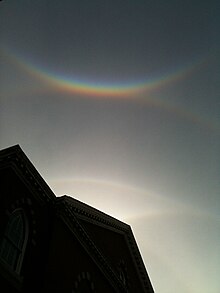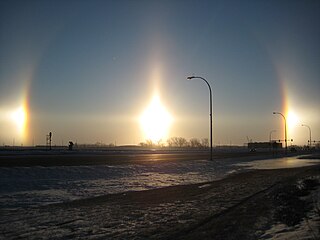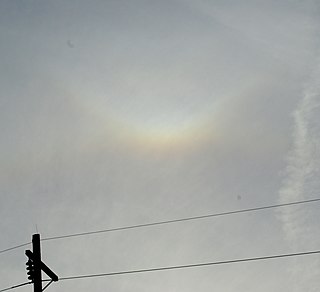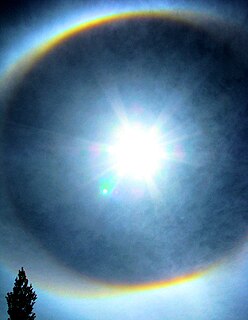

A supralateral arc is a comparatively rare member of the halo family which in its complete form appears as a large, faintly rainbow-colored band in a wide arc above the sun and appearing to encircle it, at about twice the distance as the familiar 22° halo. In reality, however, the supralateral arc does not form a circle and never reaches below the sun. When present, the supralateral arc touches the (much more common) circumzenithal arc from below. As in all colored halos, the arc has its red side directed towards the sun, its blue part away from it.

Halo is the name for a family of optical phenomena produced by sunlight interacting with ice crystals suspended in the atmosphere. Halos can have many forms, ranging from colored or white rings to arcs and spots in the sky. Many of these appear near the Sun or Moon, but others occur elsewhere or even in the opposite part of the sky. Among the best known halo types are the circular halo, light pillars, and sun dogs, but many others occur; some are fairly common while others are (extremely) rare.

A 22° halo is an optical phenomenon that belongs to the family of ice crystal halos, in the form of a ring with a radius of approximately 22° around the Sun or Moon. When visible around the moon, it is called a moon ring or winter halo. It forms as the sun- or moonlight is refracted in millions of hexagonal ice crystals suspended in the atmosphere. The halo is large; the radius is roughly the size of an outstretched hand at arm's length. A 22° halo may be visible on as many as 100 days per year—much more frequently than rainbows.

The circumzenithal arc, also called the circumzenith arc (CZA), upside-down rainbow, and the Bravais arc, is an optical phenomenon similar in appearance to a rainbow, but belonging to the family of halos arising from refraction of sunlight through ice crystals, generally in cirrus or cirrostratus clouds, rather than from raindrops. The arc is located at a considerable distance above the sun and at most forms a quarter of a circle centered on the zenith. It has been called "a smile in the sky", its first impression being that of an upside-down rainbow. The CZA is one of the brightest and most colorful members of the halo family. Its colors, ranging from violet on top to red at the bottom, are purer than those of a rainbow because there is much less overlap in their formation.














